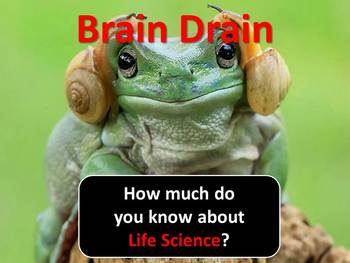Life Science Milestone Review (End of the year culminating activity)
Brainy Yak
671 Followers
What educators are saying
Used as a fun activity for the end of the year. It was not in sync with our curriculum- but the kiddos were still engaged.
This was a great activity for a substitute. It had everything that was needed and worked perfect for what we were talking about at that time. Thank you!
Description
This file contains 99 questions that go over the majority of the standards listed below. Along with the questions is a 100 slide powerpoint that coincides with EVERY QUESTION. Each slide coincides with that question on the test. This gives a visual for the students as you are going over each question. This is a great way to differentiate, verbal and visual learners.
I use these before the benchmark or CRCT as a culminating assignment to see what the students weaknesses are. I do not take it for a grade, rather candy for those that get 70 or more correct. The Answers are no more than 2 words and the students love it because they can skip around to the ones they know. Like I said, throw in candy and the students will do wonders with quick questions and answers like this.
(This can be also used for sub work if you are absent at the end of the year)
Standards:
S7L2. Students will describe the structure and function of cells, tissues, organs, and organ
systems.
a. Explain that cells take in nutrients in order to grow and divide and to make needed
materials.
b. Relate cell structures (cell membrane, nucleus, cytoplasm, chloroplasts,
mitochondria) to basic cell functions.
c. Explain that cells are organized into tissues, tissues into organs, organs into systems,
and systems into organisms.
d. Explain that tissues, organs, and organ systems serve the needs cells have for oxygen,
food, and waste removal.
e. Explain the purpose of the major organ systems in the human body (i.e., digestion,
respiration, reproduction, circulation, excretion, movement, control, and
coordination, and for protection from disease).
S7L3. Students will recognize how biological traits are passed on to successive generations.
a. Explain the role of genes and chromosomes in the process of inheriting a specific
trait.
b. Compare and contrast that organisms reproduce asexually and sexually (bacteria,
protists, fungi, plants & animals).
c. Recognize that selective breeding can produce plants or animals with desired traits.
S7L4. Students will examine the dependence of organisms on one another and their
environments.
a. Demonstrate in a food web that matter is transferred from one organism to another
and can recycle between organisms and their environments.
b. Explain in a food web that sunlight is the source of energy and that this energy moves
from organism to organism.
c. Recognize that changes in environmental conditions can affect the survival of both
individuals and entire species.
d. Categorize relationships between organisms that are competitive or mutually
beneficial.
e. Describe the characteristics of Earth’s major terrestrial biomes (i.e. tropical rain
forest, savannah, temperate, desert, taiga, tundra, and mountain) and aquatic
communities (i.e. freshwater, estuaries, and marine).
S7L5. Students will examine the evolution of living organisms through inherited
characteristics that promote survival of organisms and the survival of successive
generations of their offspring.
I use these before the benchmark or CRCT as a culminating assignment to see what the students weaknesses are. I do not take it for a grade, rather candy for those that get 70 or more correct. The Answers are no more than 2 words and the students love it because they can skip around to the ones they know. Like I said, throw in candy and the students will do wonders with quick questions and answers like this.
(This can be also used for sub work if you are absent at the end of the year)
Standards:
S7L2. Students will describe the structure and function of cells, tissues, organs, and organ
systems.
a. Explain that cells take in nutrients in order to grow and divide and to make needed
materials.
b. Relate cell structures (cell membrane, nucleus, cytoplasm, chloroplasts,
mitochondria) to basic cell functions.
c. Explain that cells are organized into tissues, tissues into organs, organs into systems,
and systems into organisms.
d. Explain that tissues, organs, and organ systems serve the needs cells have for oxygen,
food, and waste removal.
e. Explain the purpose of the major organ systems in the human body (i.e., digestion,
respiration, reproduction, circulation, excretion, movement, control, and
coordination, and for protection from disease).
S7L3. Students will recognize how biological traits are passed on to successive generations.
a. Explain the role of genes and chromosomes in the process of inheriting a specific
trait.
b. Compare and contrast that organisms reproduce asexually and sexually (bacteria,
protists, fungi, plants & animals).
c. Recognize that selective breeding can produce plants or animals with desired traits.
S7L4. Students will examine the dependence of organisms on one another and their
environments.
a. Demonstrate in a food web that matter is transferred from one organism to another
and can recycle between organisms and their environments.
b. Explain in a food web that sunlight is the source of energy and that this energy moves
from organism to organism.
c. Recognize that changes in environmental conditions can affect the survival of both
individuals and entire species.
d. Categorize relationships between organisms that are competitive or mutually
beneficial.
e. Describe the characteristics of Earth’s major terrestrial biomes (i.e. tropical rain
forest, savannah, temperate, desert, taiga, tundra, and mountain) and aquatic
communities (i.e. freshwater, estuaries, and marine).
S7L5. Students will examine the evolution of living organisms through inherited
characteristics that promote survival of organisms and the survival of successive
generations of their offspring.
Total Pages
100 pages
Answer Key
Included
Teaching Duration
N/A
Report this resource to TPT
Reported resources will be reviewed by our team. Report this resource to let us know if this resource violates TPT’s content guidelines.





